Multidisciplinary Geophysical Investigations over Deep Coal-Bearing Strata: A Case Study in Yangjiazhangzi, Northeast China
Abstract
:1. Introduction
2. Regional Geological Setting
3. Integrated Geophysical Exploration
3.1. Large-Scale MT
3.2. Aeromagnetic Survey
3.3. CSAMT and Small-Scale MT Survey
4. Drilling and Logging Interpretation
5. Discussion
6. Summary and Conclusions
- (1)
- Geophysical information needs to be integrated with the other geological results. Due to the multiplicity of geophysical solutions, geological background is indispensable in geophysical interpretation. Based on the regional geological background established using the large-scale MT survey, the investigation of coal-bearing strata can improve the accuracy of deep coal prospecting.
- (2)
- Although the resolution of magnetic methods is not high in the depth direction, it can be used to describe the stratigraphic boundary in the exploration of coal-bearing strata, which is also very meaningful for deep coal exploration.
- (3)
- The geophysical response of deep coal seams on the ground is very weak. In this case, the coal-bearing mudstone is shown as a low-resistivity area in CSAMT results, and the coal seam with higher resistivity cannot produce a sufficient geophysical response due to its large burial depth. Therefore, in the exploration of deep coal resources, it is a feasible method to take the exploration of coal-bearing strata as the first stage.
- (4)
- The multidisciplinary geophysical investigations approach in this paper can provide credible data interpretation results for deep coal seam exploration (e.g.,1000 m). We present this approach as a template that the industry can reference and build on for their deep coal exploration projects. In addition, it is obvious that the results provided by our study cannot be as accurate as drilling.
Author Contributions
Funding
Institutional Review Board Statement
Informed Consent Statement
Data Availability Statement
Acknowledgments
Conflicts of Interest
Abbreviations
| MT | magnetotellurics |
| CSAMT | controlled-source audio magnetotellurics |
| EM | electromagnetic |
| YJZZ | Yangjiazhangzi (place names) |
| NW-SE | northwest-southeast |
| TM | transverse magnetic |
| TE | transverse electric |
| 2D | two-dimensional |
| LSQR | least-squares inversion |
| UAV | Unmanned Aerial Vehicle |
References
- Chen, M.; Zang, C.; Ding, Z.; Zhou, G.; Jiang, B.; Zhang, G.; Zhang, C. Effects of confining pressure on deformation failure behavior of jointed rock. J. Cent. South Univ. 2022, 29, 1305–1319. [Google Scholar] [CrossRef]
- Wan, L.; Wang, J.; Zeng, Q.; Ma, D.; Yu, X.; Meng, Z. Vibration Response Analysis of the Tail Beam of Hydraulic Support Impacted by Coal Gangue Particles with Different Shapes. ACS Omega 2022, 7, 3656–3670. [Google Scholar] [CrossRef]
- Fan, D.; Liu, X.; Tan, Y.; Song, S.; Gu, Q.; Yan, L.; Xu, Q. Roof cutting parameters design for gob-side entry in deep coal mine: A case study. Energies 2019, 12, 2032. [Google Scholar] [CrossRef] [Green Version]
- Wang, H.; Zhang, B.; Yuan, L.; Wang, S.; Yu, G.; Liu, Z. Analysis of precursor information for coal and gas outbursts induced by roadway tunneling: A simulation test study for the whole process. Tunn. Undergr. Space Technol. 2022, 122, 104349. [Google Scholar] [CrossRef]
- Hou, W.; Wang, H.; Yuan, L.; Wang, W.; Xue, Y.; Ma, Z. Experimental research into the effect of gas pressure, particle size and nozzle area on initial gas-release energy during gas desorption. Int. J. Min. Sci. Technol. 2021, 31, 253–263. [Google Scholar] [CrossRef]
- Oldenburg, D.W.; Li, Y.; Farquharson, C.G.; Kowalczyk, P.; Aravanis, T.; King, A.; Zhang, P.; Watts, A. Applications of geophysical inversions in mineral exploration. Lead. Edge 1998, 17, 461–465. [Google Scholar] [CrossRef] [Green Version]
- Lelièvre, P.G.; Farquharson, C.G. Integrated imaging for mineral exploration. In Integrated Imaging of the Earth: Theory and Applications; Wiley: Hoboken, NJ, USA, 2016; pp. 137–166. [Google Scholar]
- Bichler, A.; Bobrowsky, P.; Best, M.; Douma, M.; Hunter, J.; Calvert, T.; Burns, R. Three-dimensional mapping of a landslide using a multi-geophysical approach: The Quesnel Forks landslide. Landslides 2004, 1, 29–40. [Google Scholar] [CrossRef]
- Lelièvre, P.G.; Farquharson, C.G.; Hurich, C.A. Joint inversion of seismic traveltimes and gravity data on unstructured grids with application to mineral exploration. Geophysics 2012, 77, K1–K15. [Google Scholar] [CrossRef]
- Sundararajan, N. A General Perspective on Geophysical Methods in Mineral Exploration. In On a Sustainable Future of the Earth’s Natural Resources; Springer: Berlin/Heidelberg, Germany, 2013; pp. 53–83. [Google Scholar]
- Criss, R.; Champion, D. Magnetic properties of granitic rocks from the southern half of the Idaho batholith: Influences of hydrothermal alteration and implications for aeromagnetic interpretation. J. Geophys. Res. Solid Earth 1984, 89, 7061–7076. [Google Scholar] [CrossRef]
- Martinez, C.; Li, Y.; Krahenbuhl, R.; Braga, M.A. 3D inversion of airborne gravity gradiometry data in mineral exploration: A case study in the Quadrilátero Ferrífero, Brazil. Geophysics 2013, 78, B1–B11. [Google Scholar] [CrossRef]
- Zeng, Z.; Chen, X.; Li, J.; Li, T.; Zhang, L. Advancement of geothermal geophysics exploration. Prog. Geophys. 2012, 27, 168–178. [Google Scholar]
- Zhang, J.; Zeng, Z.; Zhao, X.; Li, J.; Zhou, Y.; Gong, M. Deep mineral exploration of the Jinchuan Cu–Ni sulfide deposit based on aeromagnetic, gravity, and CSAMT methods. Minerals 2020, 10, 168. [Google Scholar] [CrossRef] [Green Version]
- Amatyakul, P.; Rung-Arunwan, T.; Siripunvaraporn, W. A pilot magnetotelluric survey for geothermal exploration in Mae Chan region, northern Thailand. Geothermics 2015, 55, 31–38. [Google Scholar] [CrossRef] [Green Version]
- MacGregor, L.; Tomlinson, J. Marine controlled-source electromagnetic methods in the hydrocarbon industry: A tutorial on method and practice. Interpretation 2014, 2, SH13–SH32. [Google Scholar] [CrossRef]
- Hatherly, P. Overview on the application of geophysics in coal mining. Int. J. Coal Geol. 2013, 114, 74–84. [Google Scholar] [CrossRef]
- Zheng, F. Technology of geophysical exploration of coal in China. Acta Geophys. Sin. 1994, 37, 396–407. [Google Scholar]
- Armstrong, M.; Rodeghiero, A. Airborne geophysical techniques. In Proceedings of the Coal Operators’ Conference, University of Wollongong & the Australasian Institute of Mining and Metallurgy, Wollongong, Australia, 6–7 July 2006; pp. 113–131. [Google Scholar]
- An, Z.; Di, Q. Application of the CSAMT Method for Exploring Deep Coal Mines in Fujian Province, Southeastern China. J. Environ. Eng. Geophys. 2010, 15, 243–249. [Google Scholar] [CrossRef]
- Yang, D.; Fournier, D.; Kang, S.; Oldenburg, D.W. Deep mineral exploration using multi-scale electromagnetic geophysics: The Lalor massive sulphide deposit case study. Can. J. Earth Sci. 2019, 56, 544–555. [Google Scholar] [CrossRef]
- Liu, X.; Fan, P.; Zheng, Z.; Li, A. The Yangjiazhangzi-Bajiazi molybdenum-polymetal metallogenic belt in Western Liaoning Province: Characteristics of typical molybdenum deposits and prediction for exploration. Geol. Resour. 2009, 18, 110–115. [Google Scholar]
- Tong, W.; Qingwei, W.; Longyi, S.; Yucheng, X.; Xuehai, F.; Shuzheng, N.; Zhiqing, X.; Tao, J. Current status of the research on coal geology in China. Acta Geol. Sin.-Engl. Ed. 2016, 90, 1284–1297. [Google Scholar] [CrossRef]
- Du, W.; Jiang, Z.; Li, Q.; Zhang, Y. Sedimentary characterization of the upper paleozoic coal-bearing tight sand strata, Daniudi gas field, Ordos Basin, China. J. Earth Sci. 2016, 27, 823–834. [Google Scholar] [CrossRef]
- Wu, L.; Zhang, X.; Sun, S. On the magma generation, evolution and molybdenum mineralization of the Yangjiazhangzi complex, Jinxi, Liaoning Province. Acta Petrol. Sin. 1990, 6, 1–11. [Google Scholar]
- Lu, S.; Zhao, G.; Wang, H.; Hao, G. Precambrian metamorphic basement and sedimentary cover of the North China Craton: A review. Precambrian Res. 2008, 160, 77–93. [Google Scholar] [CrossRef]
- Jasper, A.; Uhl, D.; Guerra-Sommer, M.; Bernardes-de-Oliveira, M.E.C.; Machado, N.T.G. Upper Paleozoic charcoal remains from South America: Multiple evidences of fire events in the coal bearing strata of the Paraná Basin, Brazil. Palaeogeogr. Palaeoclimatol. Palaeoecol. 2011, 306, 205–218. [Google Scholar] [CrossRef]
- Tang, X.; Zhang, J.; Shan, Y.; Xiong, J. Upper Paleozoic coal measures and unconventional natural gas systems of the Ordos Basin, China. Geosci. Front. 2012, 3, 863–873. [Google Scholar] [CrossRef] [Green Version]
- Zhang, H.; Sun, M.; Zhou, X.; Fan, W.; Zhai, M.; Yin, J. Mesozoic lithosphere destruction beneath the North China Craton: Evidence from major-, trace-element and Sr–Nd–Pb isotope studies of Fangcheng basalts. Contrib. Mineral. Petrol. 2002, 144, 241–254. [Google Scholar] [CrossRef]
- Vozoff, K. The magnetotelluric method in the exploration of sedimentary basins. Geophysics 1972, 37, 98–141. [Google Scholar] [CrossRef]
- Hautot, S.; Whaler, K.; Gebru, W.; Desissa, M. The structure of a Mesozoic basin beneath the Lake Tana area, Ethiopia, revealed by magnetotelluric imaging. J. Afr. Earth. Sci. 2006, 44, 331–338. [Google Scholar] [CrossRef]
- Sedaghat, B.; Schaa, R.; Harris, B.; Pethick, A.; Costall, A.; Duan, J.; Jiang, W. Magnetotelluric, Basin Structure and Hydrodynamics; South West of Western Australia. ASEG Ext. Abstr. 2018, 2018, 1–5. [Google Scholar] [CrossRef] [Green Version]
- Palshin, N.; Aleksandrova, E.; Yakovlev, A.; Yakovlev, D.; Breves, V. Experience and prospects of Magnetotelluric soundings application in sedimentary basins. Geophys. Investig. 2017, 18, 27–54. [Google Scholar]
- Ghaedrahmati, R.; Moradzadeh, A.; Fathianpour, N.; Lee, S.K. Investigating 2-D MT inversion codes using real field data. Arab. J. Geosci. 2014, 7, 2315–2328. [Google Scholar] [CrossRef]
- Oskooi, B.; Darijani, M. 2D inversion of the magnetotelluric data from Mahallat geothermal field in Iran using finite element approach. Arab. J. Geosci. 2014, 7, 2749–2759. [Google Scholar] [CrossRef]
- Guo, Z.; Qin, J.; Qiao, Y.; Liu, J. A GIS-based Application Framework for UAV Aeromagnetic Sensing. In Proceedings of the Near Surface Geophysics Asia Pacific Conference, Beijing, China, 17–19 July 2013; pp. 606–609. [Google Scholar]
- Abedi, M.; Gholami, A.; Norouzi, G.-H. A stable downward continuation of airborne magnetic data: A case study for mineral prospectivity mapping in Central Iran. Comput. Geosci. 2013, 52, 269–280. [Google Scholar] [CrossRef]
- Routh, P.S.; Oldenburg, D.W. Inversion of controlled source audio-frequency magnetotellurics data for a horizontally layered earth. Geophysics 1999, 64, 1689–1697. [Google Scholar] [CrossRef]
- Mühll, D.S.V.; Hauck, C.; Lehmann, F. Verification of geophysical models in Alpine permafrost using borehole information. Ann. Glaciol. 2000, 31, 300–306. [Google Scholar] [CrossRef] [Green Version]
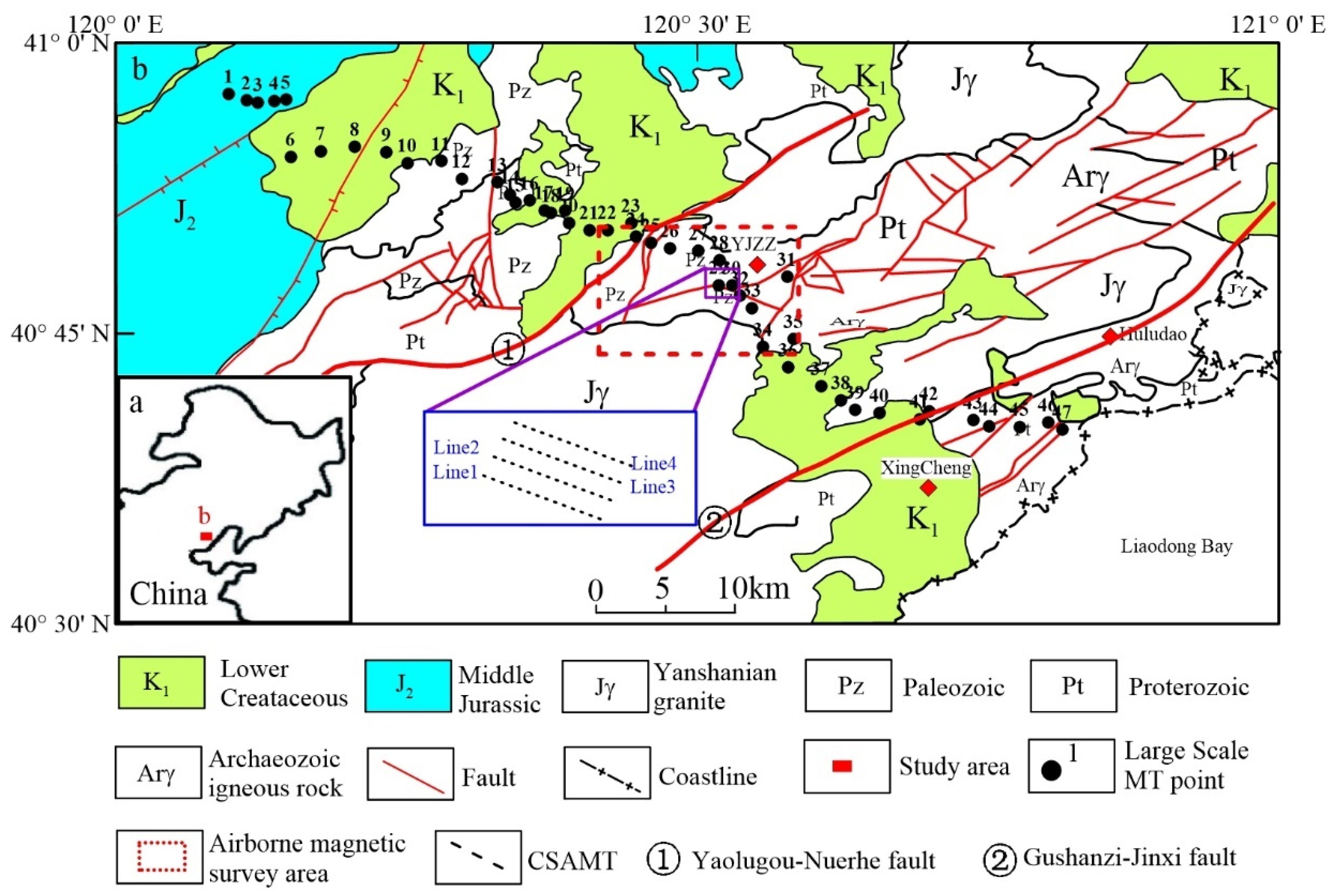
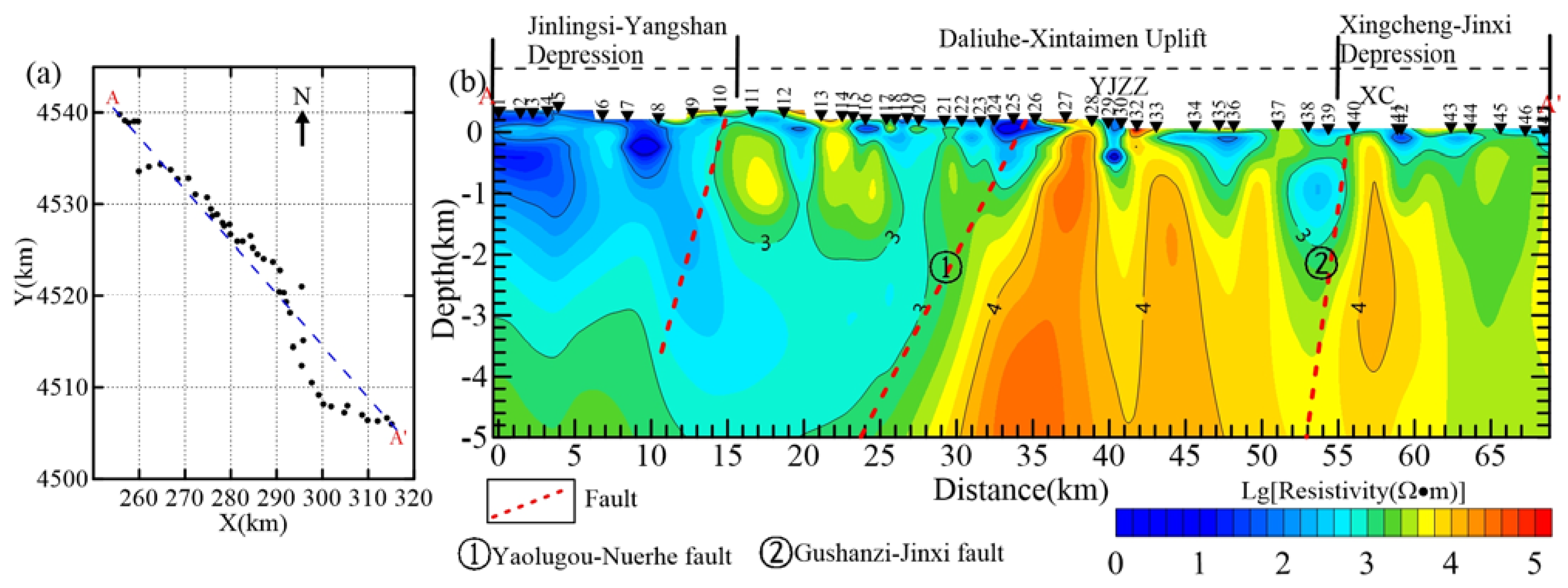
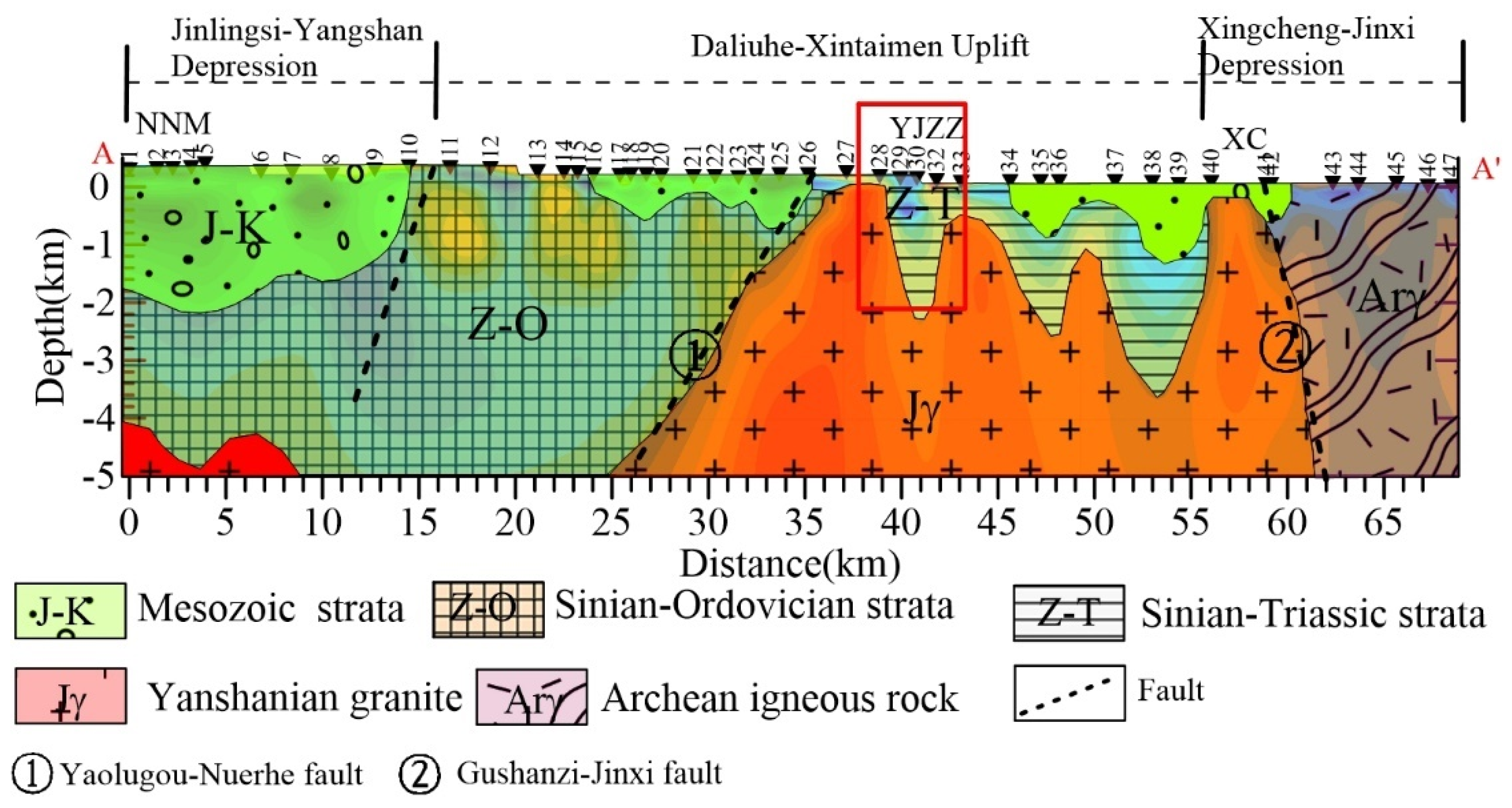
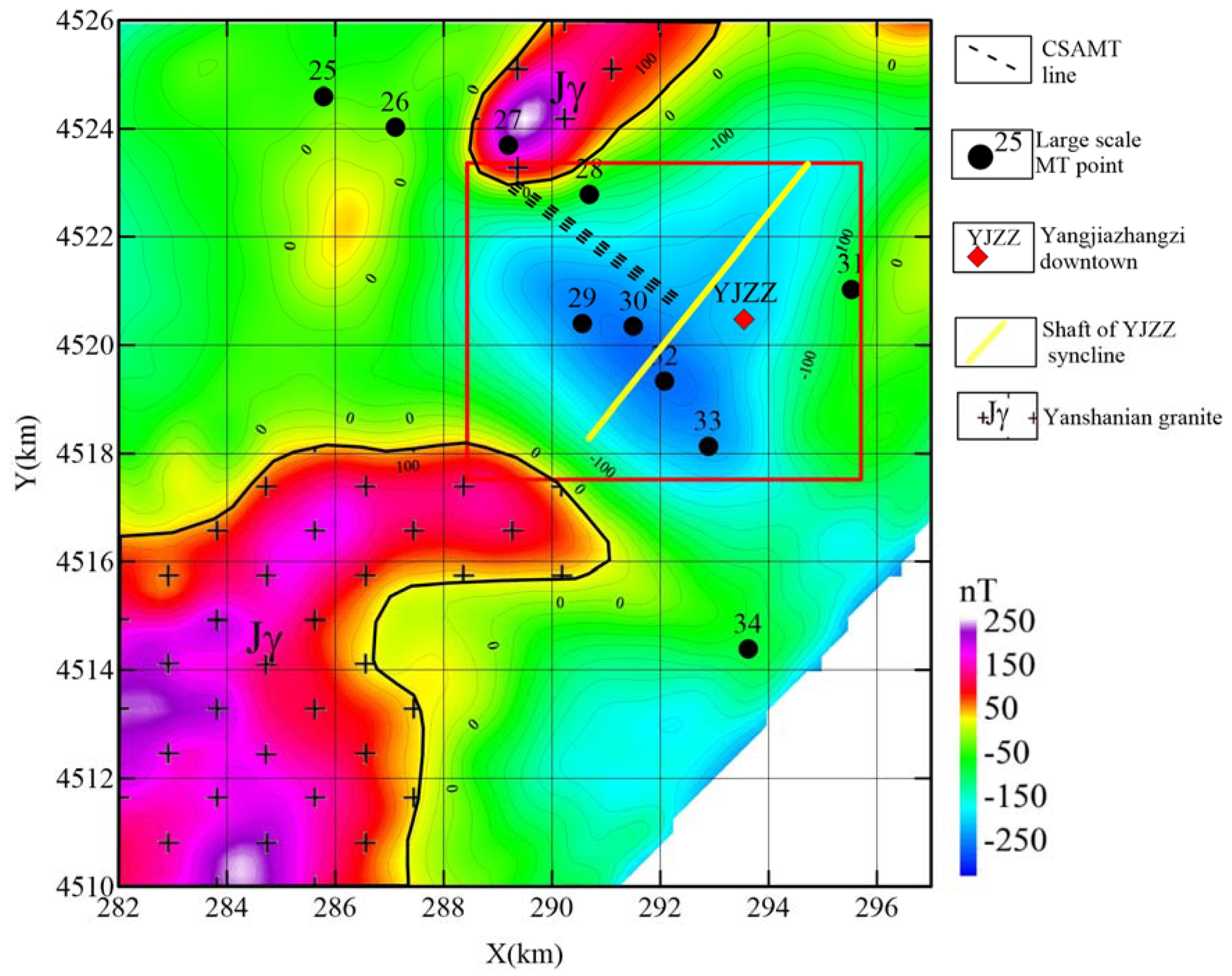
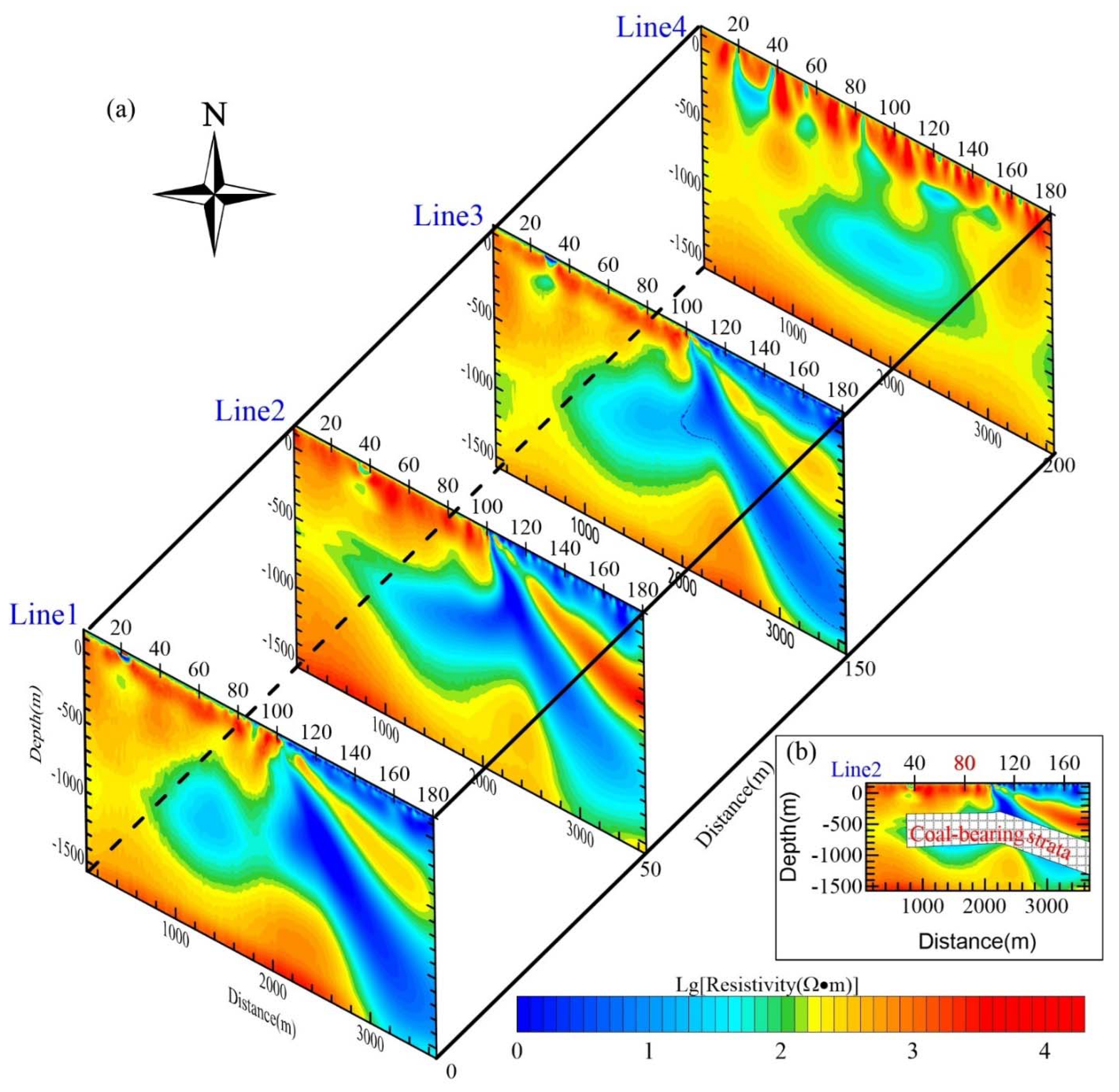
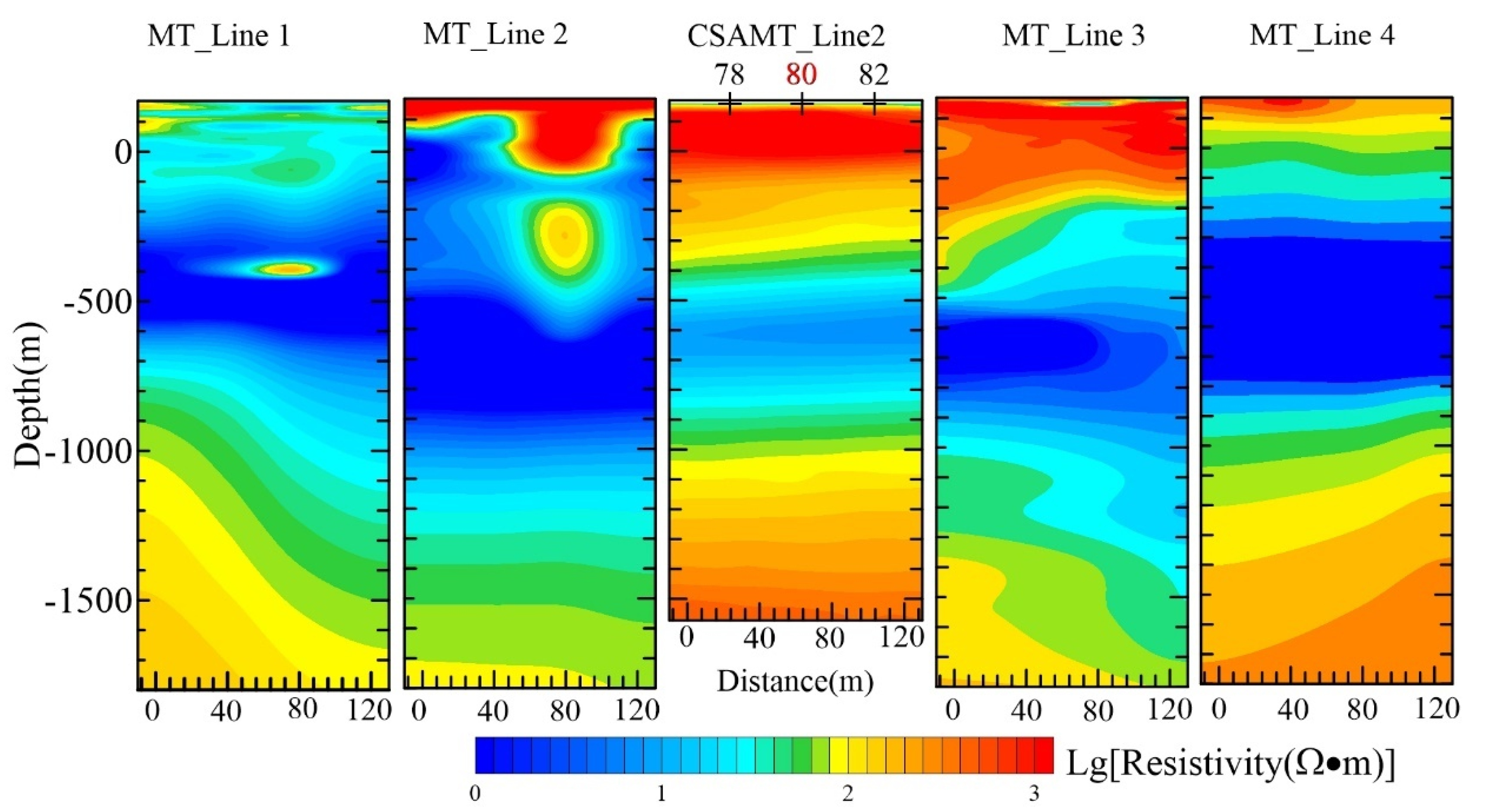
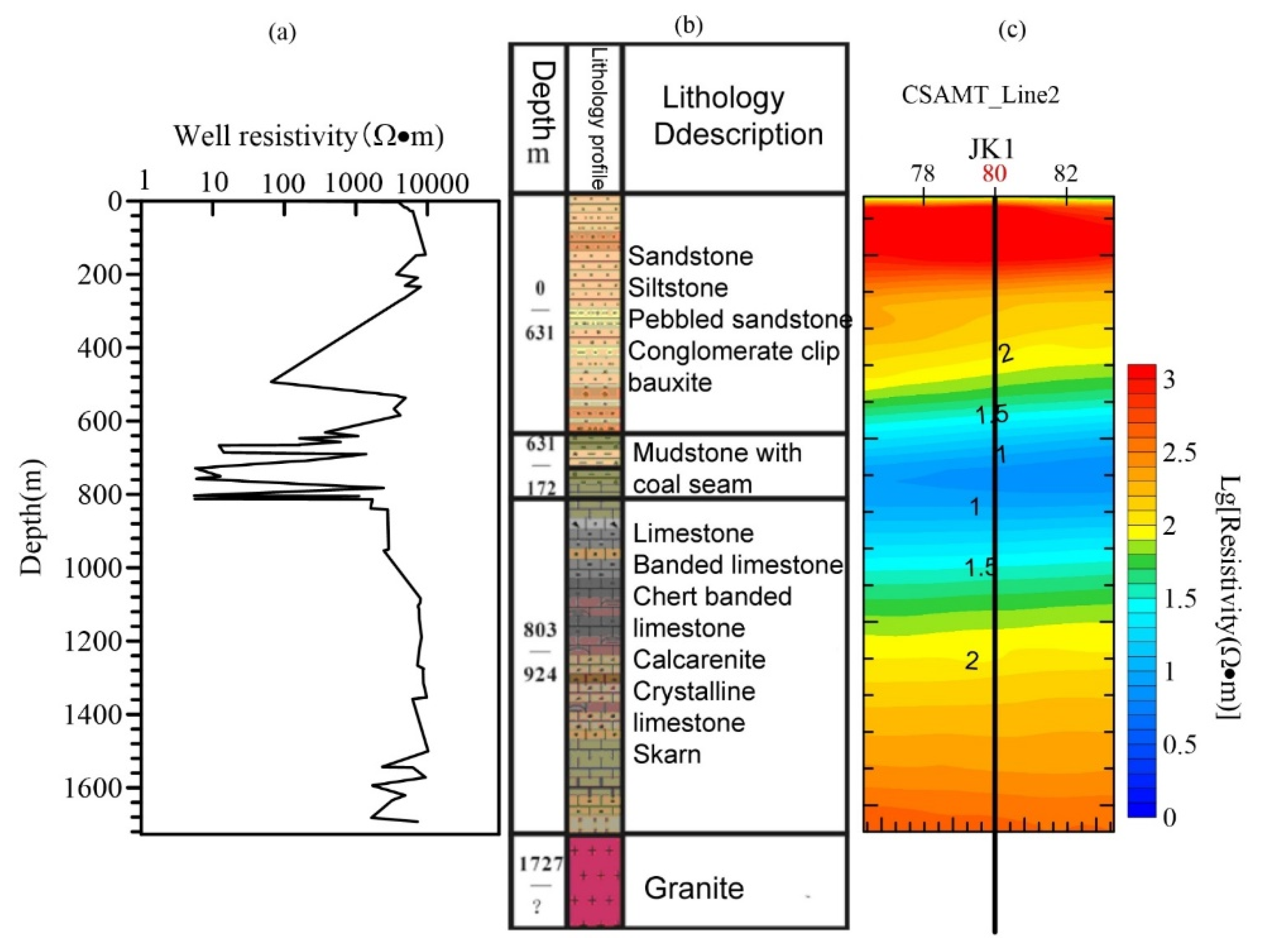
| Stratigraphic Unit | Depth (m) | Coal Seam Thickness (m) | Geological Description |
|---|---|---|---|
| Shanxi Formation | 631.34~639.56 | 1.0 | Carbon mudstone with coal |
| 1.54 | Coal seam of siltstone with aluminum soil | ||
| Taiyuan Formation | 688.76~744.4 | 2.34 | Coal seam |
| 0.7 | Bauxite with coal | ||
| 12.6 | Coal seam | ||
| 0.51 | Coal seam | ||
| Benxi Formation | 764.75~769.3 | 4.2 | Coal seam |
| Method | Physical Property | Resolution | Sensitive to |
|---|---|---|---|
| Large-scale MT | Electric conductivity | Low | Regional structure |
| Aeromagnetic | Magnetic susceptibility and/or remnant magnetization | Intermediate | Regional to local |
| CSAMT | electric conductivity | High | Local Coal-bearing Strata |
Publisher’s Note: MDPI stays neutral with regard to jurisdictional claims in published maps and institutional affiliations. |
© 2022 by the authors. Licensee MDPI, Basel, Switzerland. This article is an open access article distributed under the terms and conditions of the Creative Commons Attribution (CC BY) license (https://creativecommons.org/licenses/by/4.0/).
Share and Cite
Wang, K.; Ge, X.; Ning, J.; Li, J.; Zhao, X. Multidisciplinary Geophysical Investigations over Deep Coal-Bearing Strata: A Case Study in Yangjiazhangzi, Northeast China. Energies 2022, 15, 5689. https://doi.org/10.3390/en15155689
Wang K, Ge X, Ning J, Li J, Zhao X. Multidisciplinary Geophysical Investigations over Deep Coal-Bearing Strata: A Case Study in Yangjiazhangzi, Northeast China. Energies. 2022; 15(15):5689. https://doi.org/10.3390/en15155689
Chicago/Turabian StyleWang, Kun, Xinbo Ge, Jianguo Ning, Jing Li, and Xueyu Zhao. 2022. "Multidisciplinary Geophysical Investigations over Deep Coal-Bearing Strata: A Case Study in Yangjiazhangzi, Northeast China" Energies 15, no. 15: 5689. https://doi.org/10.3390/en15155689
APA StyleWang, K., Ge, X., Ning, J., Li, J., & Zhao, X. (2022). Multidisciplinary Geophysical Investigations over Deep Coal-Bearing Strata: A Case Study in Yangjiazhangzi, Northeast China. Energies, 15(15), 5689. https://doi.org/10.3390/en15155689







